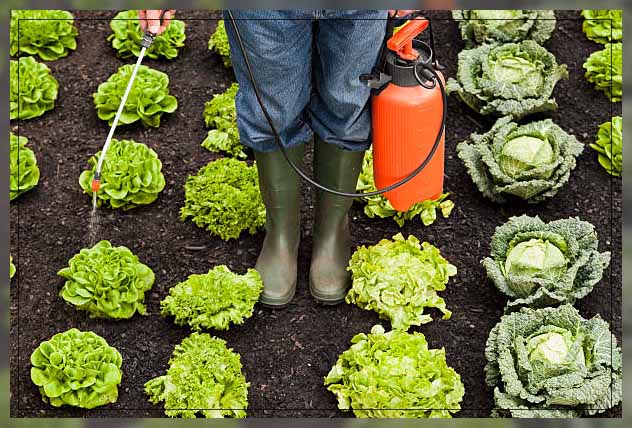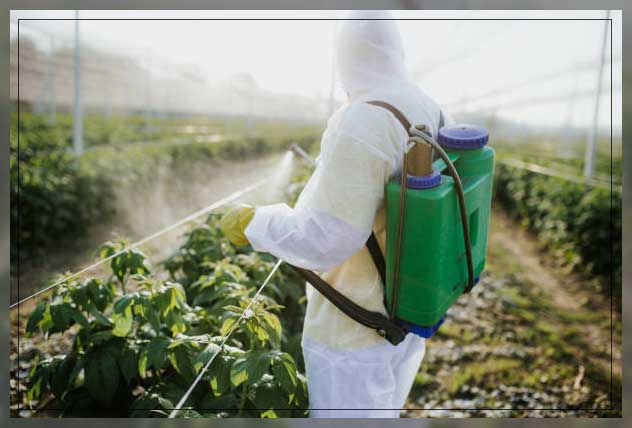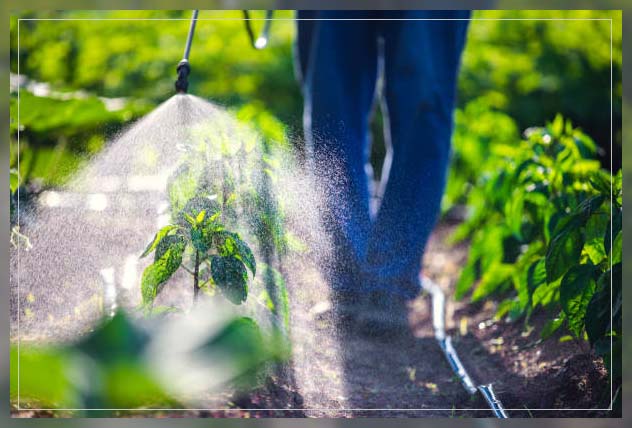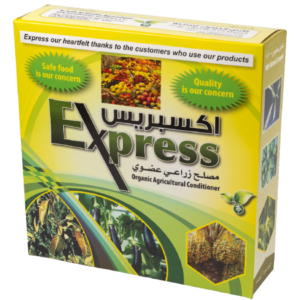Do you grow plants, fruits and vegetables? If you do, you will require pesticides.
Plants are susceptible to attack from insects, mice and rats, molds, weeds, and bacteria which collectively constitute pests.
They differ according to the type of pests.
This article discusses Pesticides, their types, advantages and risks in detail. Keep reading to know more.

Types of Pesticides
Pesticides that are used to kill insects on plants are known as insecticides.
Similarly, those that eliminate weeds that destroy vegetation are called herbicides.
Insecticides
Insects such as adult mosquitoes and other crawling insects can harm your vegetation and crops.
Hence, your vegetation is sprayed with insecticides of either solid, granule, aerosol or liquid nature.
For instance, flying mosquitoes are best targeted using aerosol sprays with droplets whereas crawling pests can be dealt with granule sprays as well.
The insecticide can affect and enter the insect in three ways.
These are:
- Dermal Entry
- Respiratory Entry
- Oral Entry
In Dermal Entry the insects’ skin comes in contact with the insecticide.
Either the aerosol spray droplets land on their skin or they walk over the spray granules laid on the floor.
Hence, dermal entry is basically, contact through the skin and cuticle.
Therefore, they are known as contact poisons for insects.
Insects breathe through spiracles hence, they can inhale insecticide droplets found in the air which is termed as an inhaled poison.
Ingested poisons make their way through insects orally.
You can put that on the plant or food to act as bait.
Or the insects may ingest them while grooming themselves and coming into contact with their skin.

Herbicides
Herbicides help to destroy unwanted plants and vegetation as well as weeds.
They can kill part of the plant as well as kill the entire plant.
They absorb into the roots, leaves and stems of the plant which eventually kills it.
Insecticides, fungicides, herbicides, they all term pesticide preventing, destroying and eliminating pests.
Others include :
- Rodenticides: These are added into food to kill mice and rats
- Fungicides: They deal with molds, rust and mildew
- Bacteriacides: These control the spread of bacteria and viruses and act as disinfectants
- Larvacides: They control larvae
- Algaecides: Slow down algae growth and even kill it
- Repellants: These repel pests by emitting a strange smell or taste
However, this is not the only classification.
They are also categorized according to their chemical forms and biodegradability.
Biodegradable pesticides break down by microbes into compounds.
These compounds are harmless and do not cause as much harm as others.
However, the other type is persistent. Persistent pesticides do not break over a period of months or even years.
Chemical Related
Some of them have a similar source, chemical forms or production methods.
For example, all organophosphates disrupt the pests’ enzymes in the nervous systems.
This obstructs neurotransmitter release. Carbamate pesticides act similarly.
Also, Pyrethrin is a naturally occurring pesticide in the flower chrysanthemums.
Pyrethroid pesticide synthetically derives from pyrethrin.
Biopesticides also derive from naturally occurring substances, materials and nature such as plants and animals and even minerals.
More so, sulfonylureas herbicides are also popular ones that control weeds.
Examples of Synthetic pesticides are boric acid, DDT and glyphosate.
You can find pest control organizations in the 21st century. In the United States environmental protection agency works for the public health to prevent pests.

Advantages of Using Pesticides
They give great benefits to the farmers, growers and overall economy.

Benefits for Farmers
It allows farmers to grow more crops and vegetation on a smaller land.
Bigger crops can grow on a small piece of land which can overall increase crop production by 30 to 50 percent.
This further allows farmers to use and invest on additional agricultural tools such as fertilizers, better seeds and water resources.
Therefore overall increasing vegetation, food quality and crop production.
This also means that agriculturists and farmers can get more yield on the same land and grow more food.
They will not spend on hand weeding but on these which are cheaper and as a result, it keeps food affordable.
Also, hand weeding is a time-consuming process. Therefore, farmer families would be engaged in hand weeding longer.
However, pesticides are quicker and will allow farmers and their families to pursue other opportunities thereby improving their living standards.

Benefits for People
Moreover, they can also control water-borne and insect-transmitted diseases.
They help to control insects and rodents and protect us from the likes of Lyme disease and malaria.
They ensure the production of more and cheaper food. Hence, food is affordable and available to the general public.
This allows people to consume aplenty fruits and vegetables which can reduce the risk of health issues.
People can stay safe from cardiac arrest, various cancers, stroke and other cardiac and nervous conditions.
They also reduce the use of land for vegetation.
Hence, less deforestation, less tillage and less soil erosion.
Therefore, they help to conserve the environment and even protect vegetation from invasive and harmful weeds.
They have also helped the economy. As crop production has increased, countries can also export these crops.
Farmers can grow two to three crops with their help.
These crops are exported to countries with temperate and humid climates with small growing seasons.
Moreover, crops are still prone to attack from pests such as mice and bacteria after harvest.
Pestocodes can protect stored food products from such pest attacks and minimize post-harvest losses and make food safer to eat.
Pesticides can eventually protect the yield and vegetation from plant disease vectors, pests, livestock disease vectors and pests that harm human health and the crops.

Risks of Pesticides
While there are more advantages, some pesticides have been banned for their persistence and effects on health and the environment.
You may come in contact with them if you use it on home grown plants and vegetables.
This happens when you touch, inhale or ingest the pesticide.
Pesticides are acutely toxic and the effects can range from harmful to lethal.
You may undergo a few symptoms after two days and such as cough, eye irritation, nausea, headache, weakness as well as loss of consciousness.
Though if you have prolonged low-level exposure to them, you may end up with certain diseases in a few years.
Some of these are Parkinson’s disease, anxiety, asthma, depression and certain cancers.
Hence, you should also get proper fumigation services for pest control and not try it yourself.
Though, it is not mandatory to work on land or grow your own crops to come in contact with them.
The pesticides droplets and granules can reach the surrounding water, air and food.
Therefore certain health conditions are linked with ingesting food with pesticides.
Pesticides pose some home on human health as well as the environment.
Some of the persistent pesticides are nonbiodegradable and can last longer in the soil.
They can also integrate in the food chain if they remain longer in the soil which can pose harmful effects to human health.
The soil quality decreases because of the chemicals in them.
This accounts for less water retention which disrupts plant growth.
Hence, the biodiversity of the soil decreases and plant growth declines.
Pesticide exposure to the general population is low.
Though they can have prolonged exposure to low levels of pesticide.
However, people who work in agricultural land are the most at risk.
Agricultural workers usually apply pesticides and are in close contact with the granules and sprays.
Therefore, they should not be in close proximity of the pesticide at application time.
People should move away after the application of pesticides to the crops.

Application of Pesticides
Pest control professional services will carry out the application carefully.
However, if you wish to use pesticides yourself then you should be careful.
You should analyze the extent of pesticides required.
After that select the pesticides that do not pose much harm to the environment and human health.
Choose biodegradable and naturally found pesticides or biopesticides for your homegrown vegetables and plants.
You should follow the exact instructions of the application and choose your mode of application.
Whether it is surface spraying for controlling crawling insects, food baits or granules for rodents, or if it is space spraying for flying insects like mosquitoes.
Moreover, fumigation treatments can control pests inside stored grain and timber.
You should use proper fumigation services however if you choose to apply the pesticides yourself then you should wear personal protective equipment (PPE).
This will minimize any exposure to pesticides while handling and applying it.
You should at least wear protective clothing like full length overalls, trouser cuffs, waterproof apron and rubber boots.
Moreover, a protective washable hat will prevent the spray to reach your hair.
Also, you should wear PVC gloves that cover your hands till elbows.
There can be splashing and pesticides air droplets may reach your face and eyes.
This can lead to acute toxic exposure. Therefore, wear a face shield and eye goggles to protect your face.
If you are an agriculturist, you should provide your employees with this basic protective equipment.
This equipment can protect agricultural workers from hazardous situations of the pesticides come in contact with their skin or if they inhale it.
Therefore, you should adopt these safety measures for pesticide use.
Conclusion
Pesticides are needed for a good harvest and have various benefits.
However, you should only use biodegradable pesticides that are beneficial for the environment and protect yourself from any harm to your health.
If used properly, pesticides can prove to be beneficial for the population and economy.






Pingback: Kitchen Garden: Design and Maintenance – Al Ard Alkhadra – Home
Pingback: Organic Food: Why is it Better than Non-Organic – Al Ard Alkhadra – Home
Pingback: Effects of Global Warming on Agriculture – Al Ard Alkhadra – Home
Pingback: Irrigation System: Types, Methods and Importance – Al Ard Alkhadra – Home
Pingback: Pest Management in Agriculture – Al Ard Alkhadra – Home
Pingback: What are the World's Staple Food Crops? - Al Ard Alkhadra - Home
Pingback: Your Ultimate Guide on Industrial Farming - Al Ard Alkhadra - Home
Pingback: Controlled Environment Agriculture: Methods and Benefits - Al Ard Alkhadra - Home
Pingback: Sustainable Agriculture and Industrial Agriculture. - Al Ard Alkhadra - Home
Pingback: Benefits of Organic Fertilizer - Al Ard Alkhadra - Home
Pingback: Land Pollution: Causes, Effects and Solutions - Al Ard Alkhadra - Home
Pingback: The Ultimate Guide on Organic Vegetables - Al Ard Alkhadra - Home
Pingback: Home Composting Basics - Al Ard Alkhadra - Home
Pingback: Pest Control Dubai - An Overview @ Al Ardh Alkhadra
Pingback: 5 Simple Shade Garden Ideas to Brighten Your Space - Al Ardh Alkhadra
Pingback: Artificial Intelligence in Farming - Al Ardh Alkhadra - Home
Pingback: Organic Gardening- Growing Your Own Potatoes - Al Ardh Alkhadra - Home
Pingback: Agricultural Waste Management: Ways and Importance - Al Ardh Alkhadra
Pingback: Regenerative Organic Agriculture : A Guide - Al Ardh Alkhadra - Home
Pingback: Regenerative Farming: 5 Principles and Practices - AAAK
Pingback: Eggshells fertilizers ( How to Use Them) - Al Ardh Alkhadra - Home
Pingback: IoT Applications in Agriculture: Everything you need to Learn AAAK
Pingback: Urban Farming: Benefits and Types - Al Ardh Alkhadra - Home
Pingback: Neem Oil as an Organic Insecticide - AAAK
Pingback: Creating a Bird-Friendly Backyard: The Basics to Know - Al Ardh Alkhadra
Pingback: Importance of Bio Stimulant in Modern Farming - Al Ardh Alkhadra